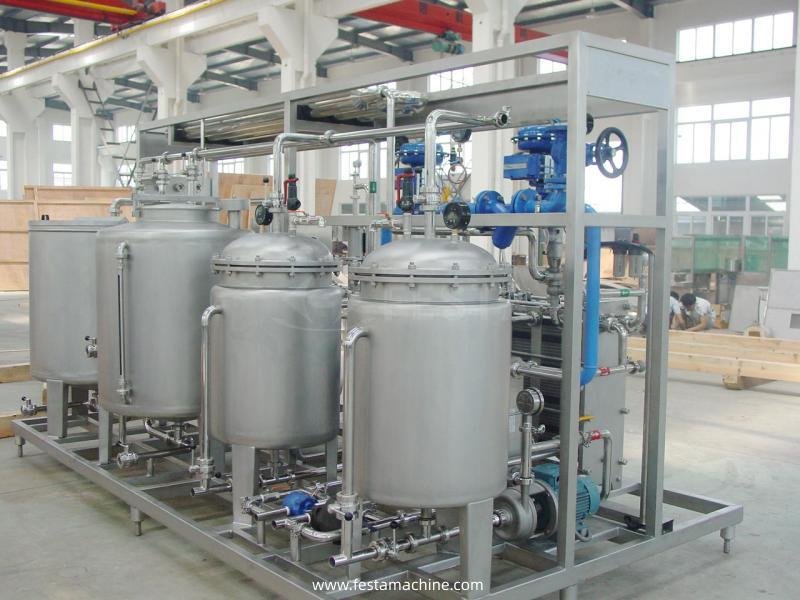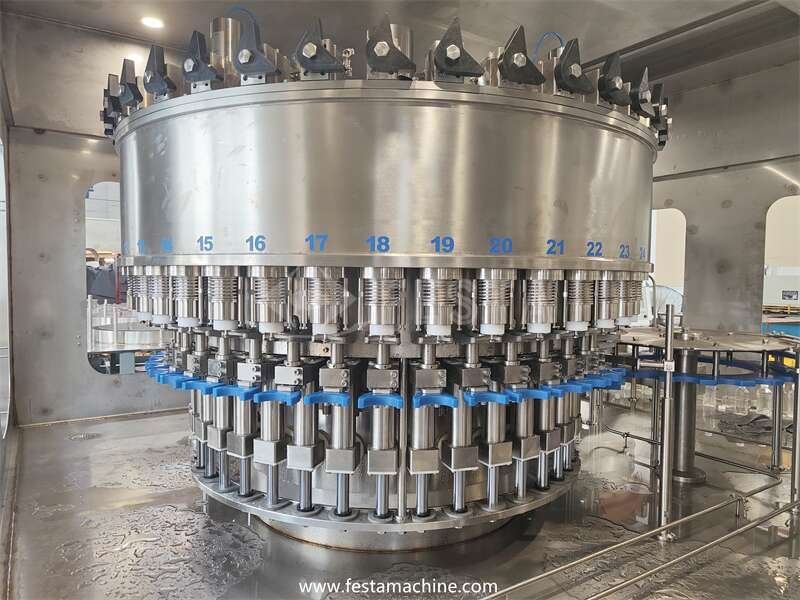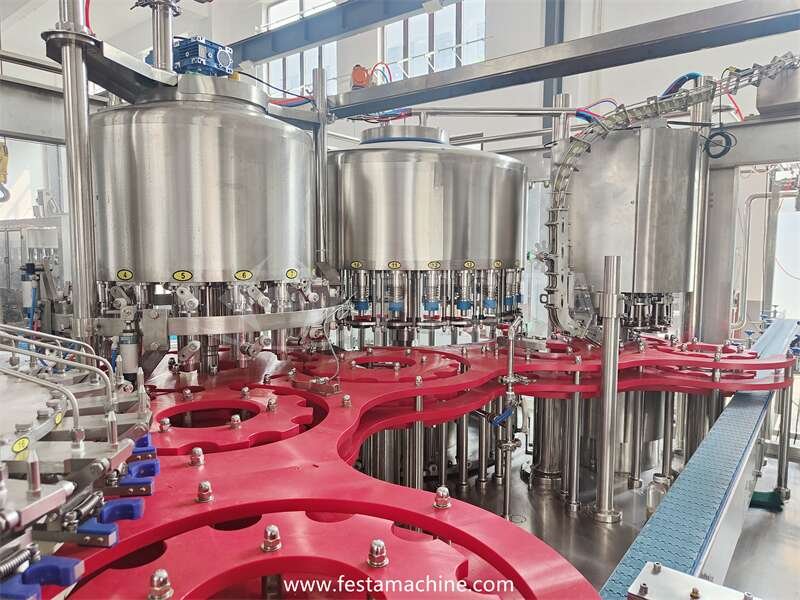UHT Sterilizer for Milk and Beverage Processing
Heat recovery – greatly reduces the need for steam and cooling media.
Using a hot water double-circulation system, the heat can be exchanged as much as possible, and enough steam can be used to meet the product sterilization temperature requirements. The temperature at the outlet exceeds the temperature at the inlet by up to 15°C, so excess energy can be saved. This also means that much less cooling medium is required.
Reduced Discharge Balance Tank to Reduce Material Loss.
The balancing tank has a special small bottom tank design that provides clear boundaries between the various mixing stages. Compared to conventional flat bottom balancing tanks, up to 75 liters of product can be saved per product change.

Description


Forward and Reverse Cleaning – Intelligent in-situ in-situ cleaning.
The easy removal of heavy dirt is also simple and time saving through a special process and the perfect design of the valve cluster. This results in more uptime and reduced energy consumption.
UHT hibernation – energy saving and power reduction.
During the sterile water cycle, the unit can be set to automatically enter sleep mode. This aseptic sleep function option reduces energy and cooling water consumption by 85%, while allowing the unit to remain sterile.
Protein Stabilization Retention Tubes – Fouling Control.
Minimizing fouling allows the machine to run for a long time and produce high quality protein products. This is achieved by optimizing the installation of temperature-controlled protein stabilization tubes.
Ultra High Temperature (UHT) sterilization
UHT products are products in which the material is heated to 135~150℃ through a heat exchanger in a continuous flow state, kept at this temperature for a certain period of time to reach a commercial sterility level, and then filled in a sterile packaging container in an aseptic state.UHT products can be distributed under non-refrigerated conditions and can be kept for a considerable period of time without product deterioration. Now, UHT products have been expanded from the initial milk to other different varieties of beverages, such as various types of fruit juices, tea drinks, etc. The sterilization temperature is 100~135℃.
(i) Purpose: To kill all microorganisms that can cause product spoilage so that the product can be stored at room temperature for a period of time.
(ii) Types of ultra-high temperature sterilization processing.
Most of the heating media used in ultra-high temperature sterilization systems are steam or hot water, which can be further divided into two categories according to whether the materials are in contact with the hot media or not, i.e. direct heating system and indirect heating system. According to the actual production situation, here mainly introduces the ultra-high temperature indirect heating system, which can be divided into plate heat exchange system and tube heat exchange system according to the different heat transfer surface of the heat exchanger, and some special products are processed using the scraper type heating system.
Plate type heat exchange system
The plate heat exchange system has many advantages: a. The heat exchanger structure is relatively compact, and the heating section, cooling section and heat recovery section can be organically combined. b. The optimized combination and shape design of the heat exchange plates greatly improves the heat transfer coefficient and heat transfer per unit area. c. It is easy to disassemble and carry out manual cleaning of the heating plate surface, and periodically check the plate surface scaling and the effect of CIP cleaning.
Tubular heat exchange systems
The advantages of the tubular heat exchange system are: a. The production process can withstand higher temperatures and pressures. b. There is a larger production capacity. c. It is highly adaptable to the product and can heat treat products with high viscosity, such as pudding.
Comparison of plate and tube type heat exchange systems
For both systems, the temperature variation is relatively close, from the mechanical design point of view:
- The plate heat exchanger provides a large heat transfer area for a small volume, and to achieve the same amount of heat transfer, the plate heating system is the most economical one.
- Tubular heating systems are more resistant to high temperatures and pressures due to the nature of their construction, while plate heating systems are limited by plates and gaskets.
- Plate heat exchangers, are more sensitive to scaling on the heating surface, as the flow path is narrower and the scale layer can quickly impede the flow of the product. In order to ensure constant flow rate, the driving pressure will increase, but the increase in pressure will be limited by the structure, especially the gasket; tube heat exchanger, due to the large temperature difference between the product and the heating medium, may be more prone to scaling than the plate heat exchanger, but scaling does not have much effect on the flow rate of the product, because the system can withstand a large internal pressure, and the constraint of continuous production is mainly the sterilization temperature, and the scaling layer affects The scaling layer affects the heat transfer efficiency, thus affecting the sterilization temperature and making automatic control impossible.
- Both heating systems, due to the influence of product scaling in the production process, cause system instability, and thus both systems should be cleaned, including AIC (Aseptic Intermediate Cleaning), which aims to remove the fat, protein and other scaling layers deposited on the heating surface, reduce the pressure inside the system, and effectively extend the one-time continuous operation time; CIP (Final Cleaning), which aims to clean the heating system thoroughly after AIC and restore the heating The purpose of CIP (final cleaning) is to thoroughly clean the heating system after AIC and restore the productivity of the heating system.
Some problems of ultra-high temperature sterilization
Heat exchange method
The heat exchange in the production process takes place by conduction and convection, and there are two cases in the heating process.
Direct heating: Steam is injected directly and uniformly into the water through an ejector, and heat is transferred to the water by conduction and convection.
Indirect heating: The hot water heated by steam passes through the partition to heat the product on the other side, and the heat is transferred from the boundary layer through the partition to the boundary layer on the other side almost entirely by conduction, and further heat transfer to the center of the product stream is accomplished by conduction and convection.
Heat Exchangers
A device that transfers heat by an indirect method is called a heat exchanger. The heat exchanger has two channels separated by a partition, where the hot water flows through one channel and the product flows through the other channel. There are two flows of product in the heat exchanger with the heating medium, a counter flow and a parallel flow.
Different products, especially dairy products, are more sensitive to heat. During the production process, when the temperature of milk is higher than 65°C, it is easy to produce a scale layer, and the temperature difference between the heat transfer surface of the exchanger and the milk is too large, which will increase the chance of protein in milk forming coke on the surface of the partition, leading to the decrease of the heat transfer coefficient. In the sterilization section, the hot water temperature is generally 2-3°C higher than the sterilization temperature of the product is preferred.
In the reverse flow process, the product is gradually heated during the stroke, and the temperature is always a few degrees lower than the temperature of the heating medium at the same point; while in the parallel flow process, the temperature difference between the two at the same point varies more. In parallel flow, the final temperature of the product cannot be higher than the temperature obtained by mixing the product and the heating medium. In reverse flow, this limitation is not present and the product can be heated to 2-3°C lower than the inlet temperature of the heating medium.
Heating process control
The product should not boil during the heating process for the following reasons The steam generated after the product boils will occupy the system flow path, thus reducing the sterilization time of the product and making the sterilization efficiency lower. Secondly. After the product boils, the flow path will produce strong turbulence due to the action of steam bubbles, resulting in a highly unstable flow and temperature in the system. Third. During the process, the bubbles generated by boiling will increase the chance of product denaturation and scaling on the heating surface, affecting heat transfer and product quality.
In order to prevent boiling, the internal pressure of the product flow path at a certain temperature should not be less than the saturated vapor pressure at that temperature. Since the main component of the product is water, this pressure is similar to the saturated vapor pressure of water, e.g., 0.2 MPa (i.e., 2 kg pressure kgf/cm2) needs to be maintained at 135°C to avoid boiling of the material, and 0.375 MPa of internal pressure is required at 150°C. Experience has shown that to better prevent boiling of the product during heating, the internal pressure provided should be at least 0.1 MPa higher than the saturated steam pressure.
Control of product flow rate and hot water flow rate
In order to reduce the scaling condition of the product on the surface of the heat transfer partition and to ensure the quality of the product, in the sterilization section, the hot water temperature is generally 2-3°C higher than the sterilization temperature of the product. To achieve this, a relatively stable ratio between the product flow rate and the hot water flow rate should be maintained. We know that the size of the flow rate to determine the product is determined by the production capacity of the filling machine, generally speaking, the hot water flow rate is 1.1 to 1.2 times the product flow rate is more appropriate. If the hot water flow rate is too low, to reach the set sterilization temperature (e.g. 137℃ for milk), more steam must be consumed to make the temperature on the hot water side rise higher, which may reach 140℃ or higher, which will greatly affect the product quality and also increase the chance of the exchanger clogging due to scaling and shorten the normal production time.




